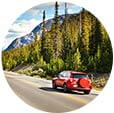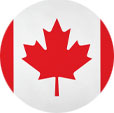Grizzly bears, caribou, wolves and elk all roam the wilderness of Canada. This vast country and its surrounding waters are rich in wildlife, and even harbour some of the world’s most elusive creatures, such as the narwhal. When exploring Canada, you’ll struggle to avoid seeing some of the country’s resident wildlife, however if you’re hoping to see a grizzly bear catching salmon, or a walrus relaxing in icy waters, there are a few amazing locations to do so. If you’re thinking of booking cheap flights to Canada and want to know the best places to see wildlife during your trip, read on.
Northwest Passage, Nunavut
Wildlife highlights: Polar bears, narwhals and walruses
Home to spectacular Arctic wildlife, the Northwest Passage in Nunavut is an iconic waterway in Northern Canada. Here you stand a good chance of spotting the Arctic Big 5 – polar bear, musk ox, walrus, narwhal and beluga whale. To maximise your chances of seeing these amazing animals, it’s advised that you join a guided tour.

The Northwest Passage is home to one of Canada’s largest groups of polar bears in the summertime. The bears gather here as the sea ice melts away to stalk their prey. Musk oxen, which resemble bison, are hard to miss. Weighing approximately 900lbs with magnificent horns and shaggy coats, these beautiful beasts feed on the tundra in small family groups. To see walrus, look out for clusters of ice, as these giant animals usually stay near the water to feast on shrimps, crabs and other molluscs. The elusive narwhal is perhaps the most difficult animal to spot, however your best bet is to visit the north coast of Baffin Island and the Lancaster Sound.
Churchill, Manitoba
Wildlife highlights: Polar bears and Beluga whales

Dubbed the polar bear capital of the world, Churchill is a remote town in northern Manitoba, on the west shore of Hudson Bay. In the autumn, many polar bears move to the shore from inland, creating a unique opportunity to spot these powerful creatures in their natural habitat. Far from any other towns or cities, the nearest large settlement is Thompson, some 250 miles south.
Those who are brave enough can get face-to-face with these fearsome animals on a tour in a tundra vehicle, a tall vehicle which is designed to move smoothly over snow and ice while protecting passengers from the polar bears. Many polar bears can grow to more than 600kg and stand over three metres tall, and so seeing these animals in the wild is a truly memorable and humbling experience.

Another majestic animal residing in Churchill is the beluga whale. These social creatures patrol Arctic and sub-Arctic waters, including in Northern Manitoba’s Hudson Bay. Head out on a kayak or a boat tour to catch a glimpse of these friendly animals.
The Great Bear Rainforest, British Columbia
Wildlife highlights: Grizzly bears, Spirit bears and wolves

Covering 6.4 million acres, this sprawling coastal region is one of the largest remaining tracts of unspoiled temperate rainforest in the world. Grizzly bears, white Kermode or ‘Spirit’ bears, black bears, cougars, wolves and salmon all thrive in this area, making it a prime place for wildlife spotting. The forest also harbours 1,000 year-old western red cedar trees and a 90-metre Sitka spruce. The Great Bear Rainforest is an important ecoregion, and its inhabitants are protected by many conservation efforts.
Karen and Ian McAllister founded non-profit conservation society Pacific Wild in 2008 but began their vital conservation efforts back in the 1980s to protect Vancouver Island’s endangered forest. In 1990, the team moved north to focus their efforts on protecting the central and north coast of British Columbia, establishing a year-round base for work in the Great Bear Rainforest. We caught up with Mike Berard, Director of Communications at Pacific Wild, to find out more about the biggest challenges facing wildlife in the Great Bear Rainforest today.
“The risk of pollution in one of the world’s most pristine waters is terrifying”
“The threats are numerous and urgent,” said Mike. “Logging has escalated at a rate that is alarming. There are multiple proposals for LNG (liquefied natural gas) projects. One of the scariest threats is articulated tug barges. They are these gigantic tug boats that move fuel and other dangerous substances through dangerous waters. People think the area is safe because of the recent oil tanker ban but – as usual – there’s a loophole. These ATBs (articulated tug barges) operate under 12,500 tonnes, so the ban doesn’t apply. One of these ATBs sunk in 2016, destroying ancestral clam beds of the Heilsuk First Nations with a fuel spill. Another ran up on a reef and almost suffered the same fate. We need a full ban on tankers. The waters up here are unforgiving, and the risk of pollution in one of the world’s most pristine waters is terrifying.”
Pacific Wild has worked hard to bring attention to a number of threats to the local wildlife in British Columbia, including publicising the province’s controversial grizzly bear trophy hunt. This led to a full grizzly bear hunting ban in 2017. “We are very proud of that one,” said Mike. “We love getting real-life results, but it takes persistence, and support from the public.”
“The archaic fear we have of wolves is irrational”
But the work to protect Canadian wildlife never ends. Mike explained some of Pacific Wild’s recent efforts: “Current campaigns include our continued push on informing the public about the wolf cull, which is cruel, embarrassing and ineffective. Wolves are crucial to a healthy ecosystem, and this archaic fear we have of them is irrational. We are gearing up to attack this issue hard again, and will create a campaign to educate the public – and the politicians – so they understand why we need wolves. Once we get a critical mass of support, we can then rally the people to pressure the government. But we have very little time. Wolves need us sooner than later, as do all the species that live in the same ecosystems. It’s hard for people to understand, but wolves actually help animals like deer and caribou to thrive. Killing wolves does not help them whatsoever. Science has proven that.
“Next up is getting the polluting fish farms out of British Columbia waters, as they are ultra-dangerous for wild salmon stocks, not to mention an insult to First Nations sovereignty.
“Essentially, we work in two ways, first we educate, and then we encourage people to take action. It’s a long and frustrating process at times, but when we get a win like we did with the grizzly hunting ban, it’s all worth it.”
You can support conservation efforts in the Great Bear Rainforest by donating to Pacific Wild, or seeking out eco-tourism opportunities. Adventure travel company Great Bear Nature Tours is a founder of the Commercial Bear Viewing Association of British Columbia, which is devoted to promoting sustainable bear viewing in the province and protecting wild bears and their habitats. The organisation offers tours at Great Bear Lodge, which was used as a base during the filming of BBC’s Secrets of Our Living Planet, and is a prime spot for watching grizzly bears in the wild.
Prince Albert National Park, Saskatchewan
Wildlife highlight: Elk, moose, black bears and mountain goats

Covering 1,496 square miles, Prince Albert National Park is a vast area, home to wolves, elk, and free-ranging bison. The bison are protected and managed, although they are free to roam wherever they please, and can often be spotted on the banks of The Sturgeon River.

The park was established in 1927 and is famous for its abundance of lakes, including the larger lakes Kingsmere, Waskesiu and Crean, which provide a sanctuary for birds. If you plan your visit around dawn and dusk, you’re in with a chance of seeing some of the park’s most exciting wildlife. If you are fortunate enough to spot elk or bears, keep a safe distance, roughly 100 metres. If you’re looking for an alternative experience of Prince Albert National Park, consider saddling up on a tour with Sturgeon River Ranch.
Banff National Park, Alberta
Wildlife highlight: Grizzly bears and Caribou

Grizzly bears, caribou, moose, bighorn sheep and mountain goats all roam the landscape in Banff National Park. Most of the backcountry in Canada’s oldest national park is subalpine forest, alpine tundra or rock and ice, perfect for grizzly bears. Parks Canada suggests that if visitors are hoping to spot a grizzly, their best bet is to drive the Icefields Parkway and the Bow Valley Parkway, but warns: “extreme caution should be taken if a bear is encountered. Grizzly bears are unpredictable and have seriously injured tourists in the past – please stay in your vehicle and give the bear lots of space”.

Banff National Park’s other residents are not quite so dangerous, and are still a sight to behold. Look out for woodland caribou grazing on the plains, and the rugged mountain goats, which can often be spotted on the Plain of Six Glaciers hike and the slopes of Mount Fairview beside Lake Louise.
Sidney, British Columbia
Wildlife highlight: Whales
Located on the northern tip of the Saanich Peninsula in British Columbia, Sidney is a quiet, picturesque town. With a population of approximately 12,000, Sidney is renowned for its prime position on the Salish Sea. Here, many species of whales can often be seen breaching the water. Sidney is also the gateway to the southern Gulf Islands National Park Reserve, which offers ample opportunities for bird watching, kayaking and even scuba diving to get a better view of Canada’s wildlife.

If you’re eager to tick whale watching off your bucket list, take a tour with Sidney Whale Watching. This family-run company has been bringing visitors closer to nature for more than 15 years, giving people the chance to see transient and resident orcas, grey whales, humpback whales, minke whales and, occasionally, fin whales. You’re also likely to spot dolphins, porpoises, sea lions, seals, river otters and spectacular sea birds. The team at Sidney Whale Watching are so dedicated to making your experience 100% worthwhile that if you don’t see a whale, you’ll be invited to join another tour free of charge.
Elk Island National Park, Alberta
Wildlife highlight: Bison

Just 35 miles east of Edmonton, Elk Island National Park is a year-round haven for wildlife. The park played an important role in the reintroduction of bison, so this is the perfect place to get up close to these magnificent creatures. Wildlife enthusiasts can also seek out moose, mule deer, elk and white-tailed deer, as well as some 250 bird species. If you’ve managed to get a cheap flight to Canada and hire a car once you’ve arrived, Elk Island is a wonderful place to set up camp for the night. It has beautifully clear skies, far away from any light pollution, so you can stargaze to your heart’s content.
Cochrane Polar Bear Habitat, Ontario
To learn more about polar bear conservation efforts during your holiday to Canada, visit Cochrane Polar Bear Habitat. Four enclosures equipped with pools, trees, rocks and natural vegetation house the reserve’s polar bears, who are orphaned, rescued or have been moved from other sanctuaries. The keepers devote their time to learning how polar bears communicate, their behaviours, needs and physiology, and are part of a wider team of scientists, biologists and researchers devoted to supporting polar bears in Canada.
Its website states: ‘The Polar Bear Habitat’s location in Northern Ontario affords us better access to communities on the Southern Coast of James Bay where recent studies have shown a marked decline in polar bear body condition. With the help of some very dedicated partners, we are committed to finding solutions to keep both communities and polar bears safe.”
Cochrane Polar Bear Habitat is open daily from 9am to 5pm, however the organisation recommends visiting in the morning, as this is when bears are most active. The facility also has a Heritage Village where you can learn about the history of Cochrane, and a Snowmobile Museum, with lots of classic snowmobiles.
Feeling inspired to explore Canada’s wildlife for yourself? Take a look at our cheap flights to Canada to start planning your adventure today. You can also book a stay at one of our environmentally-friendly wilderness lodges which put the emphasis on sustainability and responsible tourism.
Image credit: Eagle Wing Tours/Valerie Shore







